From "Centurion" to "Titan" - post-war assault bridge of the British army
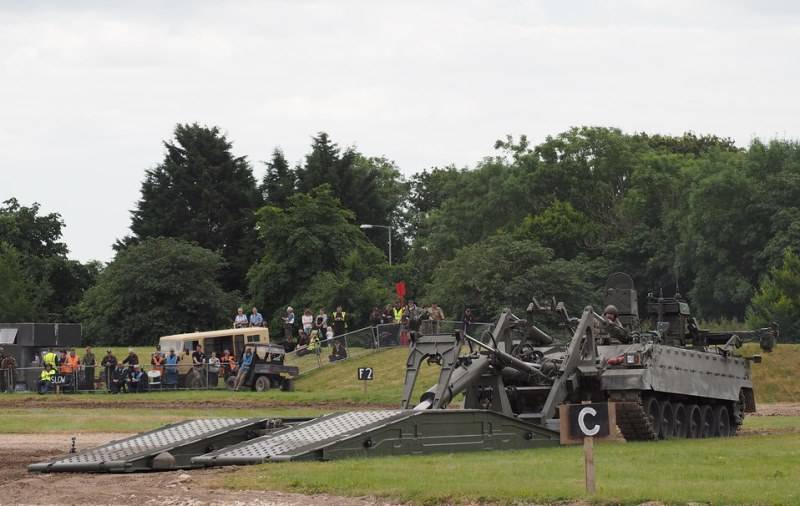
From Centurion Bridglayer to Chieftain AVLB
After the war, until the end of the 1950s, the main efforts were focused on increasing the carrying capacity of existing bridges.
So, tank Bridge No. 3 was, in fact, an evolution of Churchill with Bridge No. 2, but with an increased payload of up to 60 tons. The Churchill ARK Mark III is a similar improvement designed to fit on heavier tanks entering service. The number 4 was the scissor bridge tested on the Valentine tank, the successor to the model number 1.
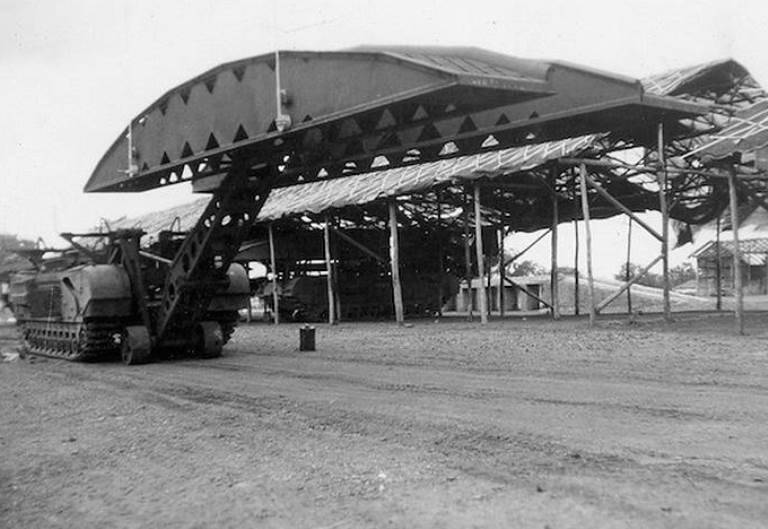
"Churchill" with bridge number 3
However, with the development of the Centurion medium tank, the next evolution of the bridges developed on the basis of this tank took place.
For example, the Centurion Bridglayer (FV 4002) bridgelayer with assault tank bridge No. 6 was a one-piece bridge mounted on top of the tank corps and was used for overturning deployment. It was raised and lowered into place using a hydraulic lever at the front of the hull. The bridge is capable of blocking an obstacle up to 13,7 m wide. The carrying capacity was 72 tons, the time for laying the bridge - up to 3 minutes, removal - 5 minutes. The very process of laying and removing the bridge was carried out without the crew leaving the car.
The bridge was calculated based on extensive testing and was a large one-piece piece that offered a reasonable compromise in terms of portability. Although the folded or scissor bridge provides less visible surface during deployment and recovery, they deploy more slowly.
Thus, object No. 6, representing a noticeable target during deployment (the bridge in a vertical position is the height of a 4-storey building), does not unfold for a long time, less than 3 minutes.
The FV 4002 assault bridge entered service in the early 1960s.
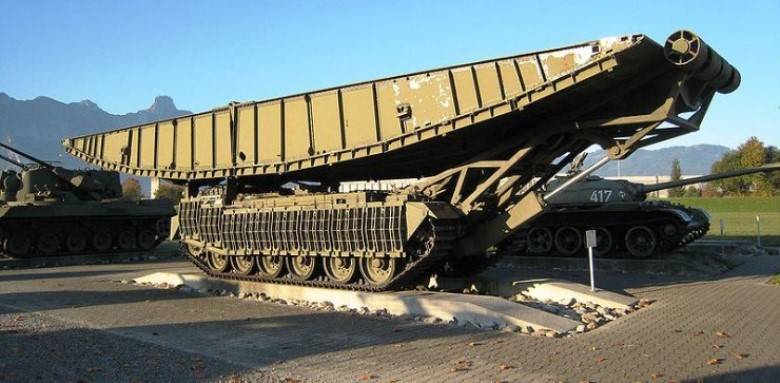
"Centurion Bridglayer" with a tank bridge number 6
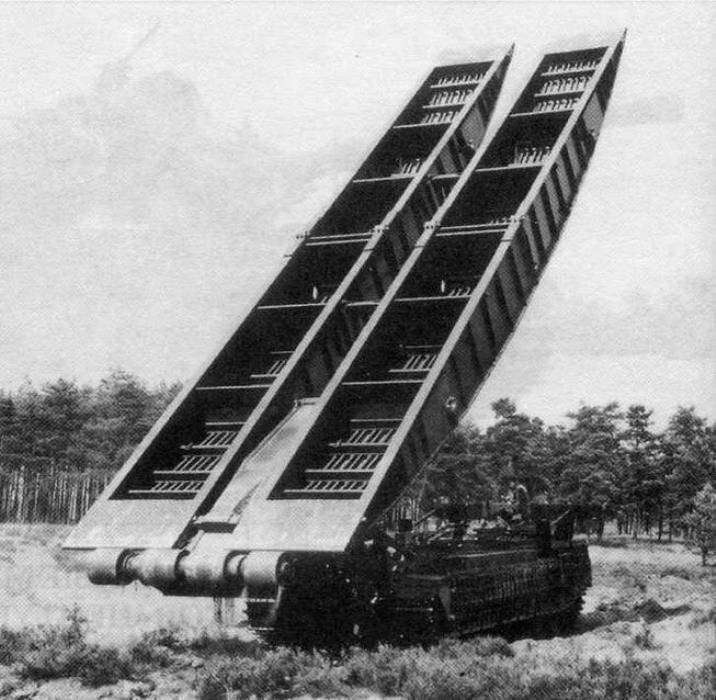
The Centurion Bridglaier is laying the bridge. The picture was taken during the testing of the machine.
The next was the Centurion ARK bridgelayer (FV 4016), which was distinguished by its bridge structure.
It consisted of two guide rails, the end ramps of which folded in half and folded out when installed using the "scissors" method. The middle carriageway was fixed on the body of the car. In the transport position, the ramps were folded onto the fixed part of the bridge. The screw mechanism made it possible to vary the track gauge for different vehicles and to reduce the width to facilitate transportation on roads and railways.
It is interesting to note that the tank itself, like its ancestor "Churchill Arc" Mk I, was used as an intermediate support when installing the bridge. The carrying capacity of the bridge was 70 tons, the width of the covered obstacle was up to 22,8 m. The laying time was 5–10 minutes.
The bridge was put into service in 1965.
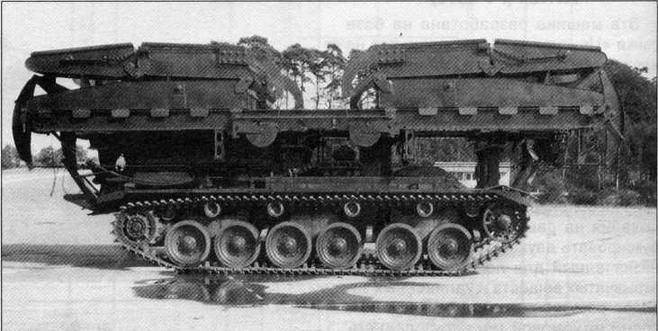
Bridge layer "Centurion" ARK in the stowed position
Another interesting derivative from the Centurion ARK was the CAMP bridge.
This option was designed to allow for the installation of Bridge No. 6 for crossing rivers that were longer than one section of Bridge No. 6 (over 13,7 m), and for use in combined bridges.
CAMP is made on the hull of the Centurion Mk 5 tank, but without the bridge structure. The car drove to the bottom of the obstacle, the depth of which should not exceed the height of the car, and served as the central support of the bridge, which was laid by at least two sections of bridge No. 6.
This vehicle entered service in 1963.
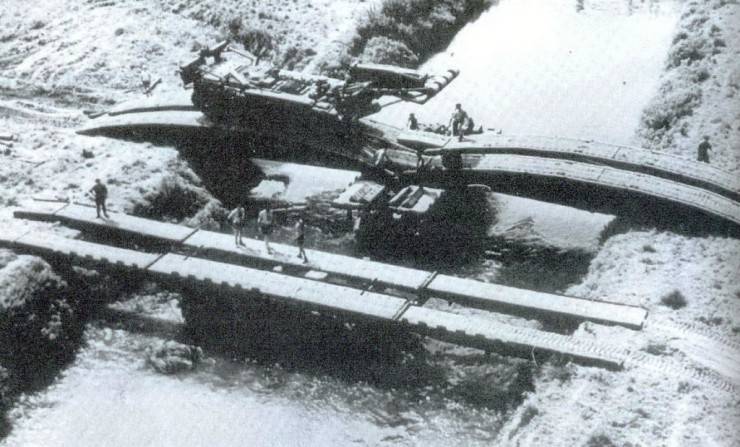
The photo "Centurion CAMP" is shown above
In the late 60s, the Centurion was replaced by the Chieftain main tank. The assignment for the development of the bridgelayer was issued by the General Staff of Great Britain in 1962.
Soon, two versions of the new bridge were presented for testing.
The first is assault bridge No. 8 FV4205 Chieftan AVLB. The unfolded structure of the bridge was 30,5 m long, the bridge covered obstacles up to 28 m wide.
The carrying capacity of the bridge was 54 tons, the crew was 3 people, the installation / removal time was 3-5 minutes.
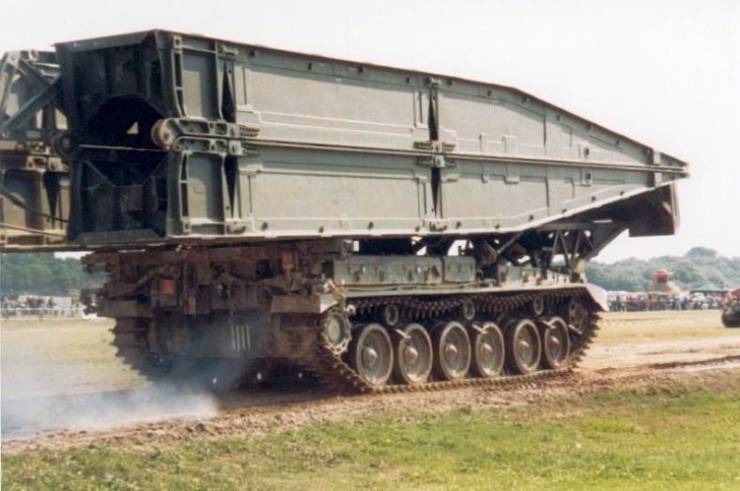
Bridgelayer "Chieftain" AVLB with bridge number 8
The second option - assault bridge No. 9 was made as a one-piece structure and had a length of 13,4 m. The bridge was laid and removed using hydraulics. The width of the covered obstacle is 12 m.
After all the tests, bridge No. 8 was adopted by the engineering troops. Its serial production began in 1975.
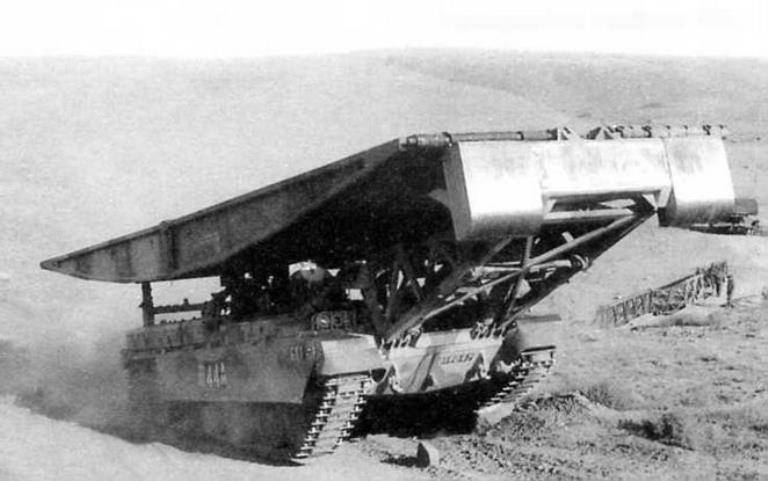
"Chieftain" AVLB with bridge number 9
Baptism of fire Assault bridges FV 4002 and FV4205 Chieftan AVLB passed during Operation Granby.
This codename was given to British operations during the 1990-1991 Gulf War. According to various sources, up to 4 FV4205 Chieftan AVLB bridgelayers were sent to the Persian Gulf as part of the 32nd Engineering Regiment of the 7th Armored Brigade. They participated in Operation Talik and ensured the advancement of tank units towards Basra. In anticipation of the armored engineers leading the attack against the formidable field fortifications and anti-tank defenses of the Iraqi army, the defenses of the bridges have been significantly strengthened.
Explosive reactive armor units were installed throughout the front of the vehicle in an attempt to protect it from most enemy anti-tank weapons. However, the bridgelayers did not have a chance to participate in active hostilities.
But they were very intensively used in the exercises that preceded the start of the operation. The main element of training is overcoming anti-tank ditches and sand embankments.
In terms of combat practice, engineering vehicles of the Chieftan AVRE type were more fortunate, which used plastic pipe fascines to overcome obstacles, as well as bulldozer equipment for making passages in obstacles.
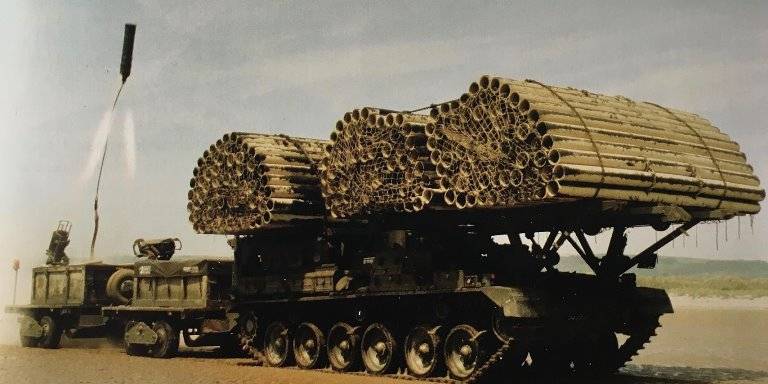
AVRE Chieftain carries 3 tube fascines and tows two Giant Viper demining trailers
In the 80s, Great Britain took part in a multinational project called Bridging for the Eighties or BR80. This program ultimately failed, but significant design work was not wasted and moved to a national program called BR90.
The resulting seven modular panels were used to build the next three types of bridges.
Tank bridge number 10. A 26m scissor bridge consisting of two 8m ramp panels, two 4m standard panels and a 2m hinged panel (see picture below). If required, the 4m panel can be removed to create a smaller bridge.
Tank bridge number 11. 16-meter bridge consisting of two 8-meter ramp panels.
Tank bridge number 12. 13,5 m long bridge consisting of one specially designed ramp panel that is not interchangeable with other panels.
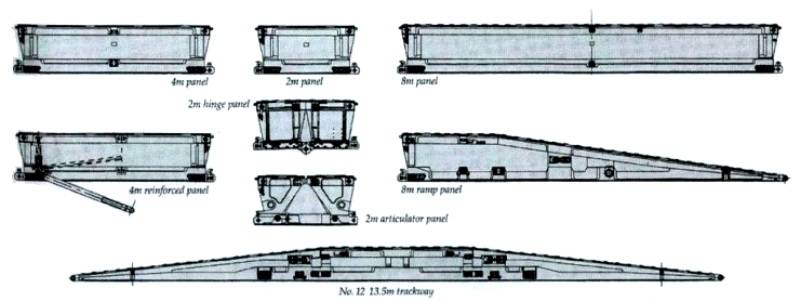
BR90 Bridge Components
All bridges can be combined into longer bridges using flyovers or floating pontoons.
Another consequence of the BR90 program is the development of the wheeled Tank Bridge Transporter, which is an integral part of the direct support axle system. The transporter is designed to transport (and only!) Heavy loads weighing up to 24 tons or to mount special military equipment.
The laying of bridge structures on the obstacle is carried out using another machine with crane equipment.
The prototype of the car was presented on February 20, 2003.
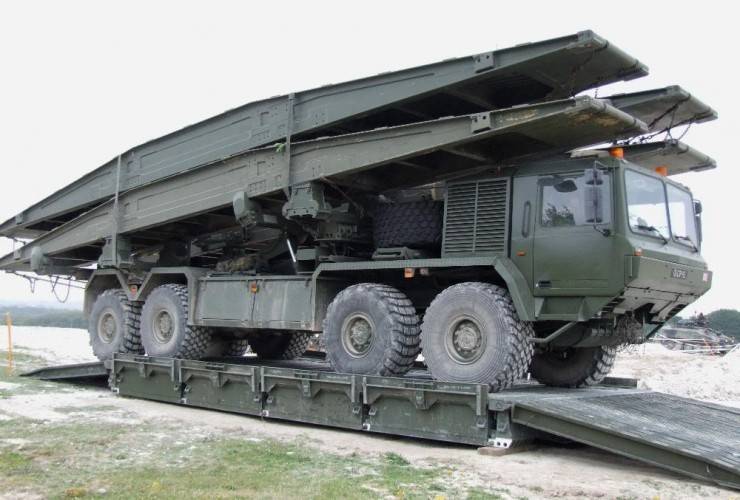
Tank bridge transporter
Modern assault bridge
The last assault bridge to enter service with the Royal Engineers is BAE Systems Titan. In 2001, 33 were ordered. "Titan" was developed on the basis of the Challenger 2 tank and can use and install bridges No. 10 (length 26 m) and No. 12 (length 13,5 m). The bridge was first shown in November 2006. Since 2007, "Titan" began to enter service.
Here's what the BAE Systems website says about Titan:
The military of the 21st Engineering Regiment were the first to receive this assault bridge, and in the summer of the same year they tested the bridge during exercises.
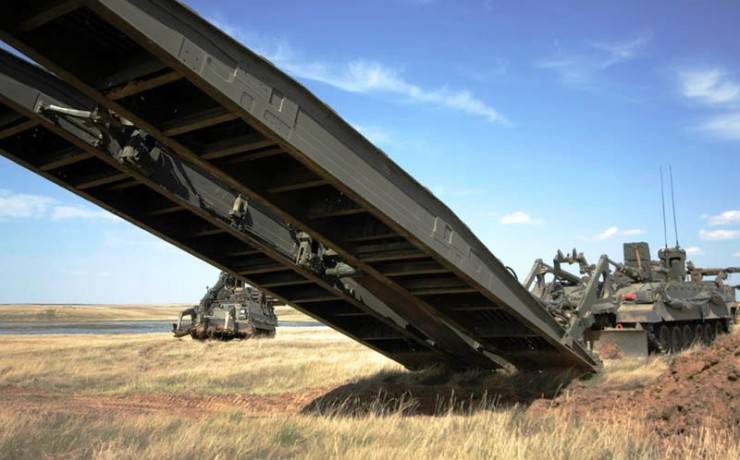
Laying bridge No. 12 during the exercise
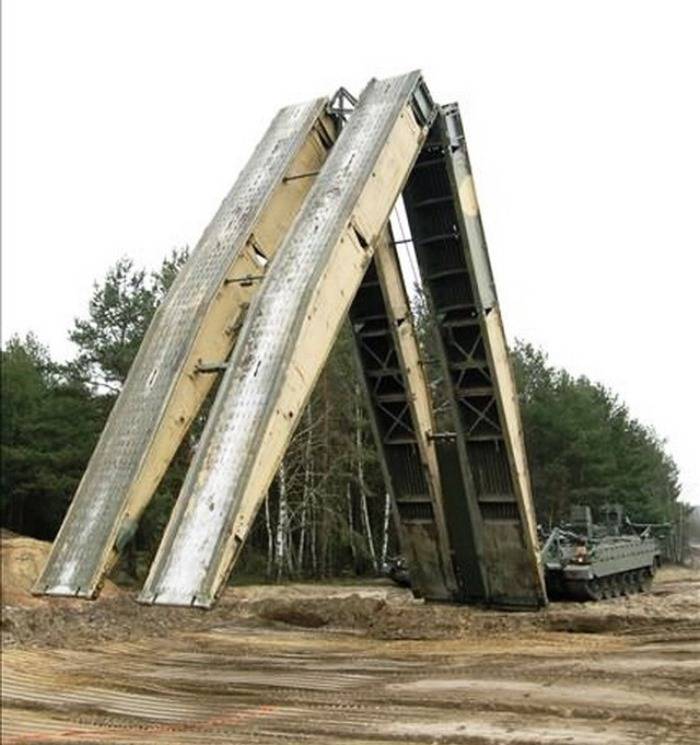
"Titan" lays the tank bridge number 10
Of the 33 Titan kits received by the army, 23 are in service with the Royal Engineers, and the remaining 10 are in training units.
In 2011, BAE Systems demonstrated a variant of the assault bridge for the Warrior BMP. The combat vehicle was equipped with a Pearson Engineering Bridge Launch Mechanism (BLM) and carried one BAE Systems # 12 bridge.
The BLM is an interesting piece of equipment as it is designed to fit a wide range of wheeled and tracked vehicles and is available in several weight categories and can also be used with removable lifting equipment.
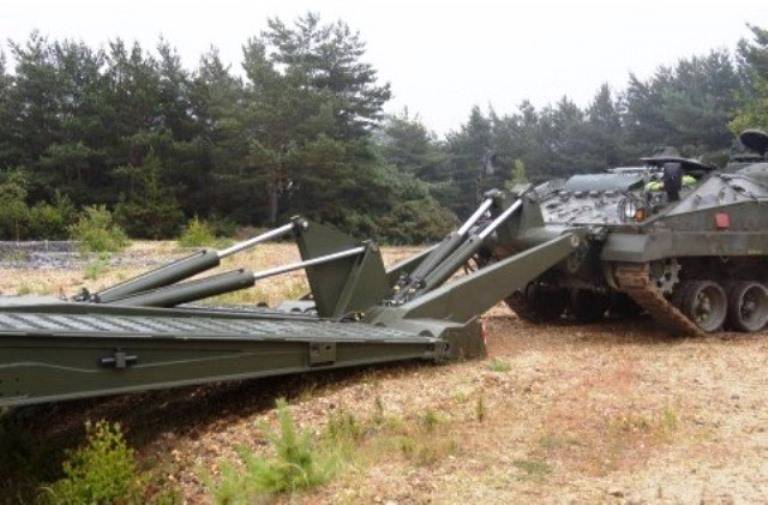
Warrior Pearson Bridge Launcher
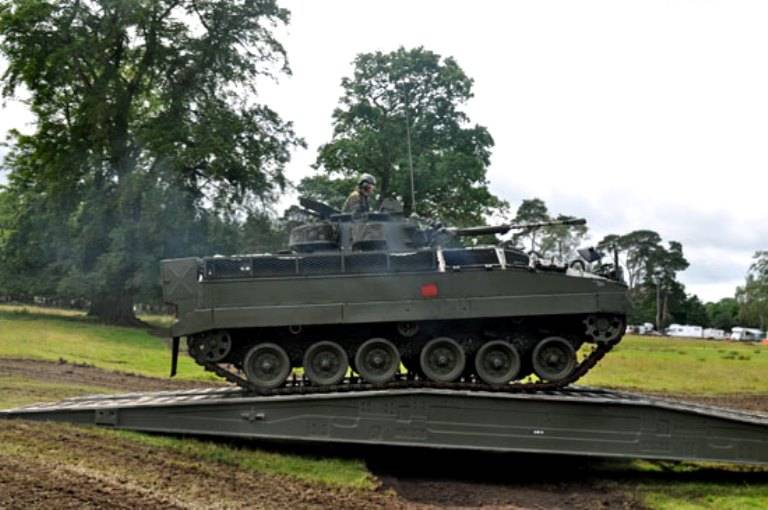
BMP Warrior overcomes an obstacle on the bridge number 12
The Bridge Launcher is a lightweight system that allows axles to be installed from a variety of vehicles.
Usually installed on tracked or wheeled platforms of the medium or heavy class. The bridge launcher mounts to the lead vehicle using the Pearson Engineering Fitting Kit, a system that facilitates attachment / detachment of front equipment and allows multiple devices to be used on the same vehicle.
During the lifting and lowering of the axle, the base of the trigger maintains contact with the ground, thereby reducing load transfer to the host vehicle and providing a stable launch platform.
In the transport position, the axle folds longitudinally over the machine.
It should be noted that the assault bridge No. 12 was planned to be installed on the Terrier engineering vehicle. However, they quickly realized that this vehicle was not as well protected as the Warrior BMP, and therefore was not capable of operating under enemy fire.
Thus, assault bridges in the British army have come a long and interesting path of development, having tested many options and designs. Today, the epitome of this titanic work is the Titan Assault Bridge, a valuable addition to the combat capabilities of the Royal Engineers' Corps.
Information